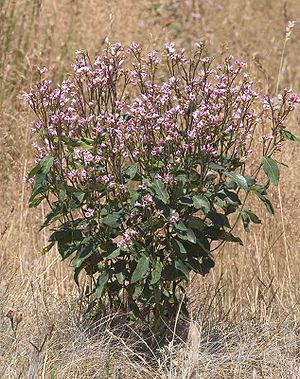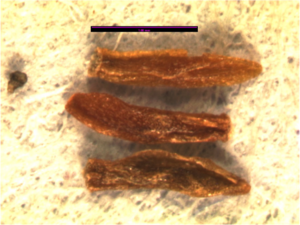Difference between revisions of "Apocynum androsaemifolium"
| Line 63: | Line 63: | ||
'''Longitudinal Cross Section:''' elliptical [[File:Apan long.png]] | '''Longitudinal Cross Section:''' elliptical [[File:Apan long.png]] | ||
{{Basics}} | {{Basics}} | ||
| − | + | ==Photo Gallery== | |
| − | + | ==References== | |
| − | + | <reference/> | |
Revision as of 12:40, 30 April 2012
Spreading dogbane
Contents
Taxonomy
Kingdom: Plantae
- (unranked): Angiosperms
- (unranked): Eudicots
- (unranked): Asterids
- Order: Gentianales
- Family: Apocynaceae
- Genus: Apocynum
- Species: A. androsaemifolium
- Binomial name: Apocynum androsaemifolium L.
- Synonyms: Apocynum ambigens, Apocynum pumilum, Apocynum scopulorum
Plant Description
A 2-5 ft. widely branching, bushy, perennial with opposite, oval leaves and small groups of tiny, pink, bell-shaped flowers near the branch tips. The flowers’ fragrance is reminiscent of lilac. Numerous small pink, nodding, bell-like flowers, fragrant and striped inside with deeper pink. Milky juice exudes from broken stems and leaves. These plants are relatives of the milkweeds. Indian Hemp (A. cannabinum), a slightly smaller species with erect clusters of greenish-white flowers, is also found in fields and is poisonous. Clasping-leaved Dogbane (A. sibiricum), found widely throughout the Northeast in sandy or gravelly habitats such as stream banks, has stalk-less or nearly stalk-less leaves.
Bloom period
June to July.
Distribution
Throughout Washington and much of Canada and the United States.
Habitat
Dry open rocky woods, thickets, roadsides in open areas from low to fairly high elevations. Typically found growing in sandy or gravelly, dry soils.
Uses
First Nations
One of the digitalis group of cardiac tonics, apocynum, is the most powerful in slowing the pulse, and its action on the vaso-motor system is also very strong. Being rather irritant to mucous membranes, it may cause nausea and catharsis, so that some cannot tolerate it. It is a powerful hydragogue, helpful in dropsies due to heart-failure, and in the ascites of hepatic cirrhosts has been called the 'vegetable trocar.'
Women of some tribes rolled dogbane stem fibers on their legs to make fine thread, said to be finer and stronger than the best cotton thread. It was used for sewing and for making twine, nets, fabric and bowstrings.
Other Uses
These plants are relatives of the milkweeds. Indian Hemp (A. cannabinum), a slightly smaller species with erect clusters of greenish-white flowers, is also found in fields and is poisonous. Clasping-leaved Dogbane (A. sibiricum), found widely throughout the Northeast in sandy or gravelly habitats such as stream banks, has stalkless or nearly stalkless leaves. Women of some tribes rolled dogbane stem fibres on their legs to make fine thread, said to be finer and stronger than the best cotton thread. It was used for sewing and for making twine, nets, fabric and bowstrings. The poisonous, acrid sap was said to stimulate hair growth by irritating the follicles, but people with sensitive skin are more likely to develop blisters than hair.
Propogation
The flowers bloom in June and July. Pods, slender hanging down 7-20cm long. S
Seed
Abbreviation: APAN
Seed sample from: 2009
Average Measurement: 1.8 x 0.4 x 0.2
Measurement Range: L: 1.2 – 2.1, W: 0.2 – 0.5, D: 0.1 – 0.3
Features
Shape: Narrow at hilum end, and opposite apex. Seed somewhat flattened.
Color: Hilum white against brown seed body.
Surface: Longitudinally ribbed with small glossy globules. Seed lustrous.
Latitudinal Cross Section: elliptical ![]()
Longitudinal Cross Section: elliptical ![]()
Basic Explanations and Assumptions:
The dimensions for the seeds are length x width x depth. The location of the hilum is used as the base of the seed, and the length is measured from hilum to the opposite apex. Where a style is present, the length is measured from the hilum to the bottom of the style. Width is measured at a right angle to the length at the widest part. Depth is measured at a right angle to the intersection of height and width lines.
Measurements included are the mean average for each measurement of ten separate seeds.
All measurements in millimeters unless otherwise noted.
Photo Gallery
References
<reference/>- ↑ http://www.nativeplantnetwork.org/network/ViewProtocols.aspx?ProtocolID=1405,1826 |Propagation Protocol from Native Plant Network


